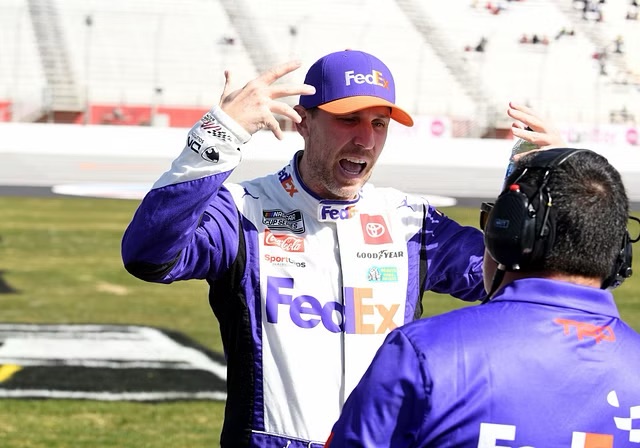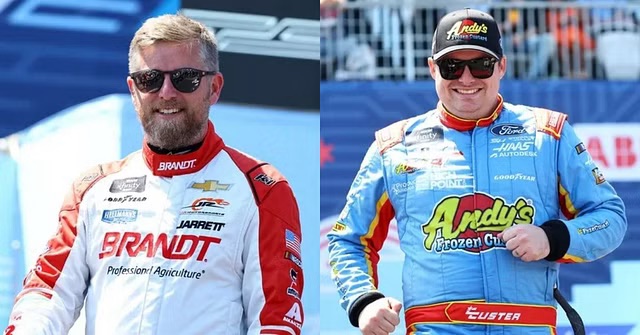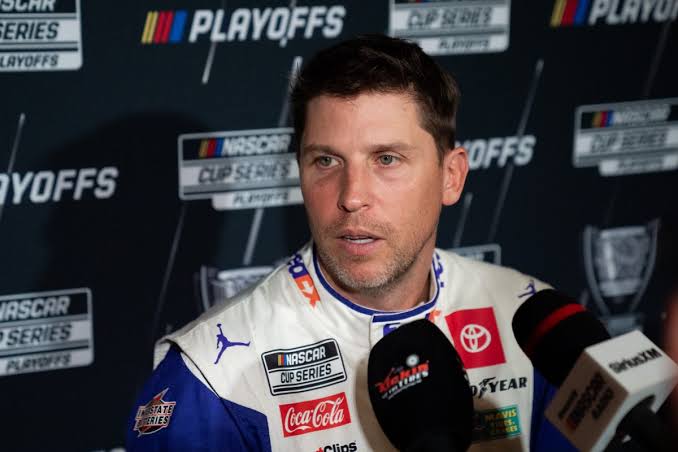Denny Hamlin’s 24th-place finish at Atlanta was largely the result of a strategy focused on accumulating points and a late-race wreck that compounded the issue. This outcome, combined with Hamlin’s current standing in the playoffs, leaves him only a few points above the cutline with just two races remaining in the Round of 16. Given how critical these final races are, Hamlin’s approach at Atlanta has drawn considerable criticism from both fans and NASCAR insiders alike.
The decision to hang back during the race, avoid racing at the front, and not push for stage points was a curious one, especially given the unpredictable nature of superspeedways where avoiding wrecks is always a challenge. While Hamlin is one of the most skilled superspeedway drivers in the series, his unaggressive strategy put him in a vulnerable position.
Former NASCAR driver and current analyst Kyle Petty voiced his confusion regarding Hamlin’s race-day decisions, expressing bewilderment at the team’s overall approach to the race. Petty wasn’t alone in his critique; NASCAR spotter Brett Griffin also weighed in on Hamlin’s strategy on a recent episode of the Door Bumper Clear podcast. Griffin didn’t hold back in expressing his disbelief at Hamlin’s conservative tactics during the race. He expressed frustration, saying, “What the f**k was he thinking? He rode around the back all day. He got no stage points, he got in a wreck, he’s lucky he came out of here above the cutline. And he’s one of the smartest superspeedway racers out there, obviously you could drive from the back to the front, we saw other drivers do it, including …I think… his teammate Ty Gibbs… I think Denny’s probably going to wish he had that one back” (46:25).
Griffin pointed out that Hamlin is regarded as one of the best superspeedway racers in the sport. Fans are used to seeing Hamlin’s prowess at tracks like Daytona and Talladega, where strategic drafting and bold moves are essential to staying ahead of the pack. Yet, at Atlanta, which has its own unique superspeedway characteristics, Hamlin chose to play it safe by staying at the back, hoping to avoid accidents. Ironically, this cautious approach may have cost him, as he ended up involved in a wreck towards the end of the race anyway.
Griffin also commented on what could lie ahead for Hamlin in the coming races, specifically Watkins Glen and Bristol. He speculated that Hamlin could score a substantial number of points at Watkins Glen and head into Bristol, a track where he tends to perform well, with a buffer above the cutline. However, there’s another, more concerning scenario. If Hamlin fails to secure enough points at Watkins Glen, he could go into Bristol with a sense of urgency and anxiety, making him vulnerable to the type of chaotic short-track racing that often claims unsuspecting drivers.
“Bristol is just like Atlanta,” Griffin warned. “You can get caught in somebody else’s wreck very easily.”
Griffin’s surprise at Hamlin’s Atlanta strategy wasn’t just limited to Hamlin. He also questioned the role that Hamlin’s crew chief, Chris Gabehart, played in shaping this race plan. He wondered whether this was a collective decision or something that came down more to Hamlin’s own preferences as a driver. In Griffin’s eyes, the whole situation felt like a race “given away,” with Hamlin’s points advantage over drivers like Brad Keselowski now dangerously thin.
In addition to Griffin’s sharp remarks, Hamlin’s strategy also attracted the attention of fellow Door Bumper Clear co-host Freddie Kraft. Kraft, who serves as Bubba Wallace’s spotter, expressed his own frustration, saying that Hamlin had essentially given up the points cushion he had coming into the playoffs. “He just forfeited the gap he had,” Kraft said. “He came in with like a 15-point gap to the cutline and now he’s 1 or 2 points ahead of Brad Keselowski. Now you just gave a race away, essentially. I get it, you gain points on Kyle Larson who wrecked, you gain 12 points. And to top it all off, you ride around the back so you don’t get in a wreck… and then he wrecks on the last lap” (49:00).
Kraft further elaborated on the fan perspective, noting that some were frustrated with Hamlin’s passive approach. He revealed that while driving back from Atlanta, he overheard fans complaining that they had spent money to watch their favorite driver race, only to feel like they hadn’t really seen him compete at all. According to Kraft, the question remains whether Hamlin should care about these fan grievances or simply focus on the larger picture, which is his ultimate goal of winning a championship. However, Griffin speculated that while Hamlin himself likely doesn’t care too much about fan discontent, it’s still worth noting that fans’ frustrations could lead to them switching their loyalty to other drivers, which can have a long-term impact on a driver’s popularity and overall brand.
Hamlin’s Atlanta strategy and the backlash surrounding it highlight the delicate balance that drivers must maintain during the playoffs—between playing it safe to ensure a spot in the next round and racing aggressively enough to stay competitive. For Hamlin, the decision to prioritize safety over aggression backfired, leaving him in a more precarious position heading into the next two critical races. While his skills and experience make him one of the favorites to advance to the next round, the margin for error has now shrunk considerably. How Hamlin adjusts his approach in the upcoming races at Watkins Glen and Bristol will determine whether his Atlanta strategy was a fluke or part of a larger game plan that will ultimately pay off.




